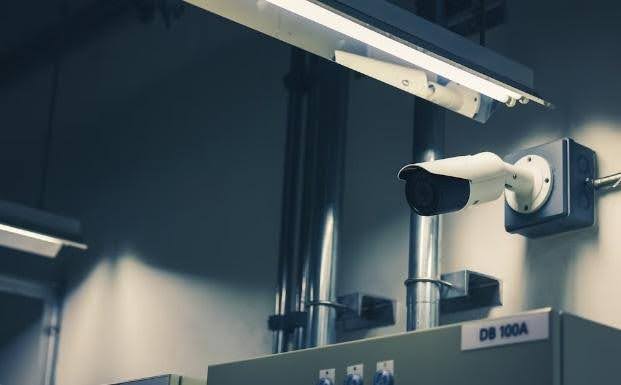TABLE OF CONTENTS

I think many people suppose the “facial recognition” is the function which is included in digital cameras and smartphone camera apps. This is a system that detects people’s faces in captured images and determines whether they are smiling or not.
In recent years, facial recognition systems, which are more advanced versions of this facial recognition function, have been used for security management when entering and exiting facilities. In this article, we will introduce “facial recognition systems”, which are currently rapidly becoming popular. If you are looking to improve security measures in your office or factory, please use this as a reference.

A facial recognition system is a technology that authenticates a person’s face to confirm their identity and is one type of biometric authentication that is used in a variety of situations.
Biometric authentication technology, including facial recognition, is now widely used not only in companies and factories but also in financial institutions, government agencies, etc. that require strong security.
(1)Main types of authentication systems
<Face recognition terminal (device) type>
This method involves installing a device such as a dedicated camera and performing authentication using that device. Its features include fast authentication speed, low running costs, and personal information is managed within the building.

(2) Authentication method for face recognition
<Visual method (2D authentication)>
The visual method (2D authentication) is a method that authenticates the positions of eyes, nose, mouth, etc. by comparing them with information in a database.
<IR method (3D authentication)>
The IR method (3D authentication) recognizes and authenticates the entire face as 3D data. Although the visual method is compatible with many devices, the IR method has higher authentication accuracy.
<Advantage 1: Contactless authentication>
Fingerprint authentication and vein authentication cannot be authenticated without physically touching the device. However, facial recognition can be performed without touching the device. Therefore, it has been attracting more and more attention in recent years as it can help prevent infectious diseases such as the new coronavirus. Additionally, since there is no need for employees to have an IC card, there is no need to worry about what to do if an employee forgets or loses their IC card.
<Advantage 2: Can be used in a wide range of situations>
Facial recognition can recognize many people at once without having to authenticate each person one by one.
For example, when combined with surveillance camera footage, it can be useful when searching for lost children at theme parks, shopping malls, etc. In addition, by linking with an attendance management system, more accurate attendance management is possible by performing facial recognition when employees enter and leave the room. Of course, it can also be used for access control in offices and factories and can be used for a variety of purposes.
<Advantage 3: High accuracy>
Facial recognition is equipped with advanced AI, allowing for highly accurate recognition. The fact that more and more countries are introducing facial recognition systems for immigration procedures at airports is proof of their accuracy and convenience. Systems that allow authentication while wearing glasses or masks have also been developed, making them even more convenient. It also helps prevent fraud such as identity theft.
| Entry/exit at companies/offices, etc. | Facial recognition systems are also often used to authenticate individuals when entering and leaving offices and business offices. Traditional card authentication using employee identification cards, etc., has the risk of theft or loss, but using a facial recognition system to manage entry and exit can prevent not only theft and loss but also impersonation, increasing security. In addition, entry/exit management using facial recognition systems can also be applied to attendance management and room occupancy management. |
| Entry/exit within the factory | When passing through the factory, people often use fingerprint authentication or IC cards such as employee ID cards to authenticate their identity, but recently facial recognition systems have increasingly been introduced. Facial recognition systems enable contactless identification, making it easier for staff to enter and exit the security area of the factory while carrying luggage with both hands. |
| Store shoplifting measures | By installing equipment in areas where customers are sure to pass, such as store entrances, and collecting data, you can develop countermeasures in the event of trouble such as shoplifting. By identifying shoplifters, you can be more careful when they return to the store, minimizing losses for your store. |
| When passing through the airport | Facial recognition systems are also used at airports around the world when passing through security checkpoints, boarding gates, entry/exit gates, and customs electronic declaration gates. |

| Contents covered by compensation | Compensation amount(VND) |
|---|---|
| Privacy matters | Facial recognition systems perform authentication using personal information such as a person’s face, which can uniquely identify an individual. Therefore, when implementing a facial recognition system, extreme care must be taken when handling the data. |
| Authentication accuracy | Although facial recognition systems are rapidly evolving, there are differences in systems depending on the system. With the spread of the new coronavirus, systems equipped with a “mask mode” are also being developed. When determining the accuracy of the facial recognition system your company employs, you need to consider its functionality depending on the purpose. |
| How to save data | The image data captured by facial recognition systems is extremely large and takes up a lot of space. Therefore, when saving image data, you need to consider where and for how long. |

In recent years, an increasing number of customers in Vietnam have been introducing facial recognition systems to improve convenience and security.
ALSOK Vietnam Security Services, not only provides facial recognition systems, but also provides security measures using facial recognition technology, countermeasures against shoplifting, and other optimal solutions depending on the customer’s needs. If you have any further questions or consultations, please feel free to contact us.